Fattorini H.O., Kerber A. The Cauchy Problem
Подождите немного. Документ загружается.

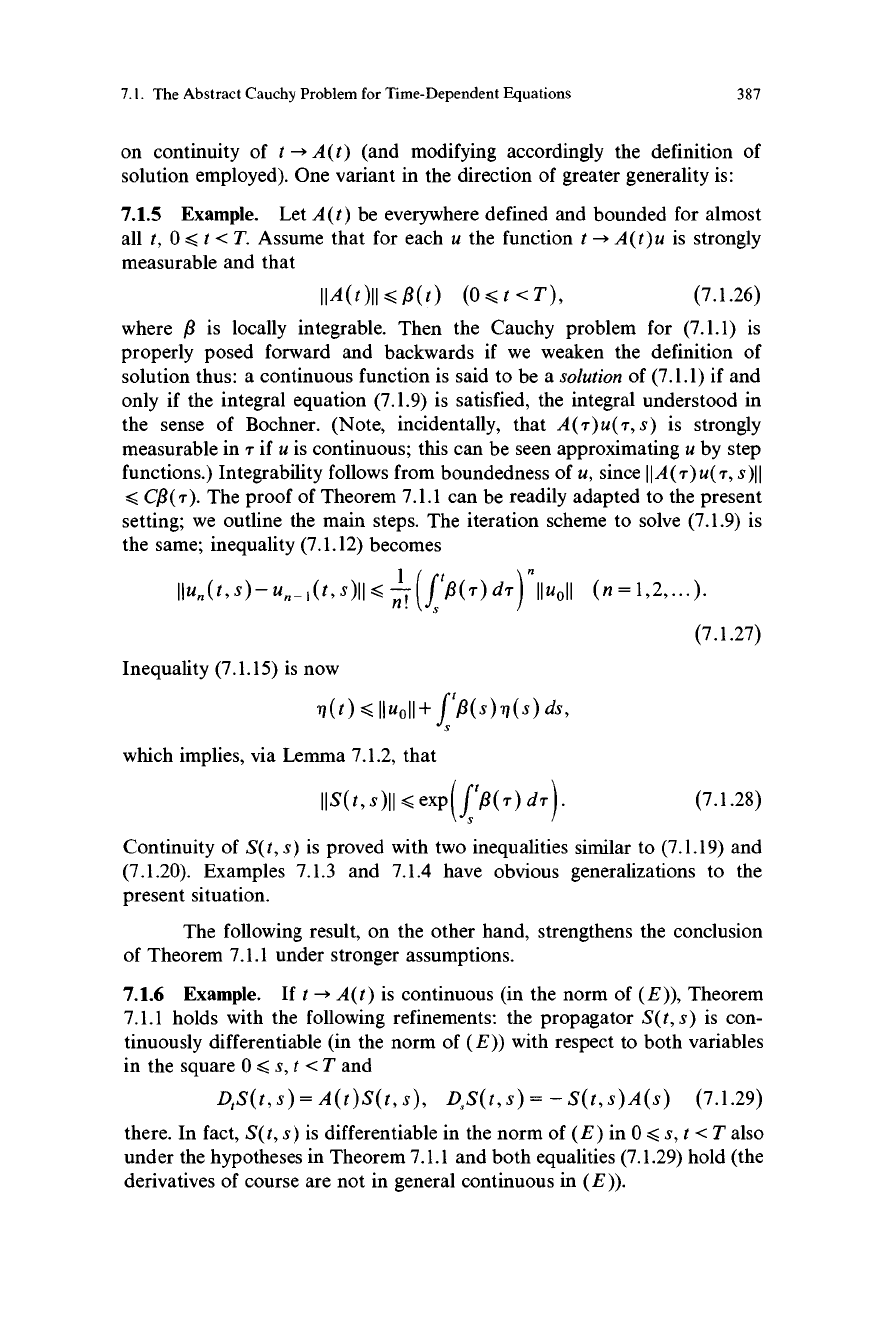
7.1. The Abstract Cauchy Problem for Time-Dependent Equations
387
on continuity of t -A (t) (and modifying accordingly the definition of
solution employed). One variant in the direction of greater generality is:
7.1.5
Example. Let A(t) be everywhere defined and bounded for almost
all t, 0 < t < T. Assume that for each u the function t - A(t) u is strongly
measurable and that
IIA(t)II <a(t) (0<t<T),
(7.1.26)
where $ is locally integrable. Then the Cauchy problem for (7.1.1) is
properly posed forward and backwards if we weaken the definition of
solution thus: a continuous function is said to be a solution of (7.1.1) if and
only if the integral equation (7.1.9) is satisfied, the integral understood in
the sense of Bochner. (Note, incidentally, that A(T)u(T, s) is strongly
measurable in T if u is continuous; this can be seen approximating u by step
functions.) Integrability follows from boundedness of u, since IIA(T)u(T, s)II
< C$(T). The proof of Theorem 7.1.1 can be readily adapted to the present
setting; we outline the main steps. The iteration scheme to solve (7.1.9) is
the same; inequality (7.1.12) becomes
I
Ilun(t,s)-un-1(t,s)II <
n1
(f t$(T)dT)nIIu01I
S
Inequality (7.1.15) is now
I1u011+ f ds,
s
(n 1,2,...)-
(7.1.27)
which implies, via Lemma 7.1.2, that
IIS(t, s)II <
exp(f ta(T) dT).
(7.1.28)
S
Continuity of S(t, s) is proved with two inequalities similar to (7.1.19) and
(7.1.20). Examples 7.1.3 and 7.1.4 have obvious generalizations to the
present situation.
The following result, on the other hand, strengthens the conclusion
of Theorem 7.1.1 under stronger assumptions.
7.1.6
Example. If t - A(t) is continuous (in the norm of (E)), Theorem
7.1.1 holds with the following refinements: the propagator S(t, s) is con-
tinuously differentiable (in the norm of (E)) with respect to both variables
in the square 0 < s, t < T and
D,S(t,s)=A(t)S(t,s), DS(t,s)=-S(t,s)A(s) (7.1.29)
there. In fact, S(t, s) is differentiable in the norm of (E) in 0 < s, t < T also
under the hypotheses in Theorem 7.1.1 and both equalities (7.1.29) hold (the
derivatives of course are not in general continuous in (E)).
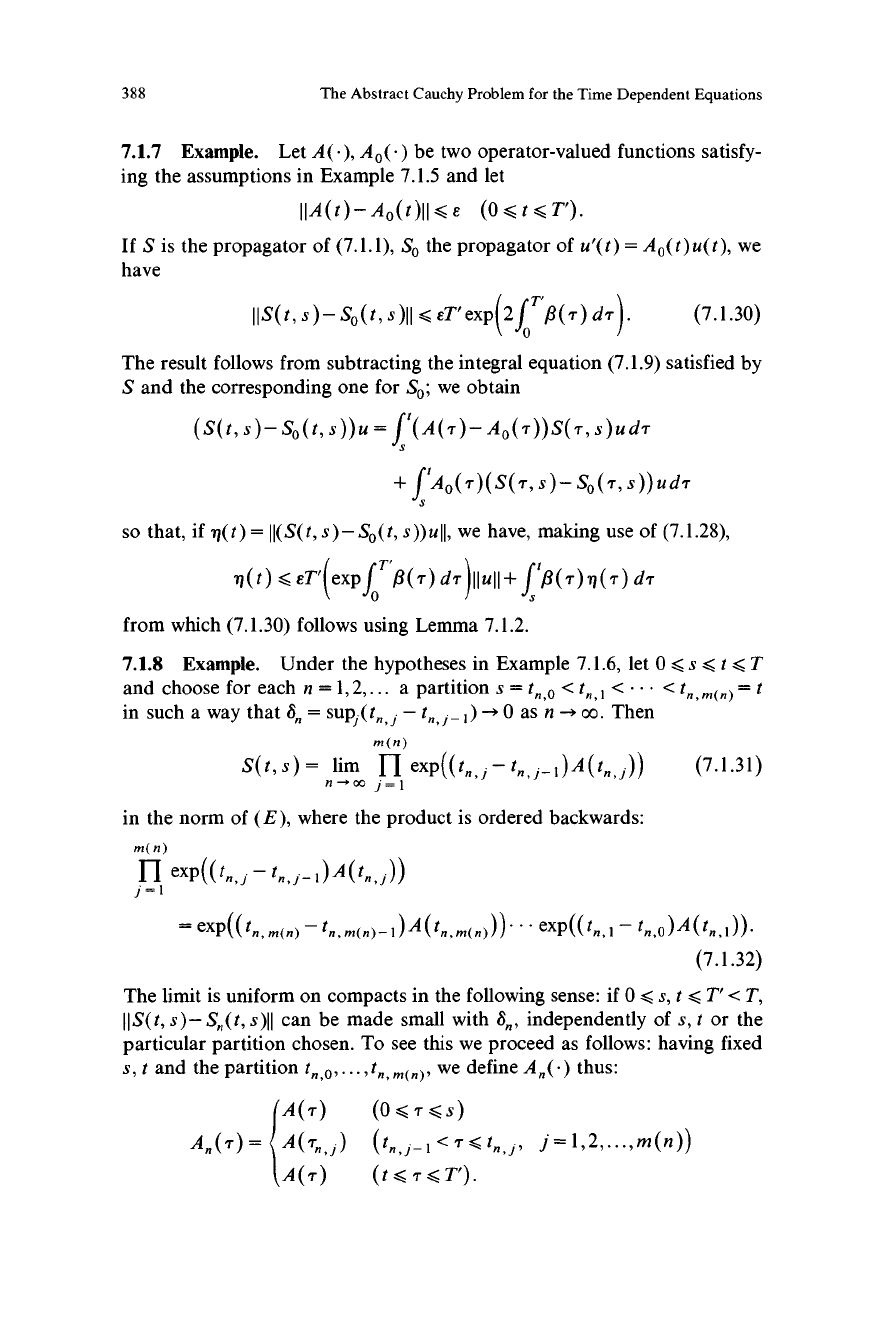
388
The Abstract Cauchy Problem for the Time Dependent Equations
7.1.7
Example.
Let A(-),
be two operator-valued functions satisfy-
ing the assumptions in Example 7.1.5 and let
IIA(t)-Ao(t)II<e (0<t<T').
If S is the propagator of (7.1.1), So the propagator of u'(t) = A0(t)u(t), we
have
IIS(t,s)-So(t,s)II<ET'exp(2 fT113(T)dT).
(7.1.30)
The result follows from subtracting the integral equation (7.1.9) satisfied by
S and the corresponding one for So; we obtain
(S(t,s)-S0(t,S))u= f
t(A(T)-AO(T))S(T,s)udT
S
+ f tAo(T)(S(T,s)-S0(T,s))udT
so that, if q(t) = II(S(t, s)- S0(t, s))uII, we have, making use of (7.1.28),
rl(t)<eT'(exp f T Q(T)dT)IIuII+ f IQ(T)rl(T)dT
from which (7.1.30) follows using Lemma 7.1.2.
7.1.8 Example.
Under the hypotheses in Example 7.1.6, let 0 < s < t < T
and choose for each n =1, 2.... a partition s = tn,o < tn,1 <
< tn,
m(n) = t
in such a way that 8n = sups (t
n i - to 1 _ 1) -+ 0 as n - oo. Then
m(n)
S(t, s) = lira
11 exp((tn,l - tn, j_i)A(tn,j)) (7.1.31)
n-00 f=1
in the norm of (E), where the product is ordered backwards:
m(n)
I1
eXp((tn,j-tn,l-1)A(tn,j))
r=1
=
exp((tn
m(n)-tn,m(n)
I)A(tn,m(n)))...eXp((tn,1-tn,0)A(tn,1))
(7.1.32)
The limit is uniform on compacts in the following sense: if 0 < s, t < ' < T,
I I S(t, s) - Sn (t, s )II can be made small with Sn, independently of s, t or the
particular partition chosen. To see this we proceed as follows: having fixed
s, t and the partition tn,0+... I tn,m(n), we define An(-) thus:
A(T) (0<T<s)
An(T)
=
A(Tn,l)
(tn, j-1 <T <tn,J, J=1,2,...,m(n))
A(T) (t<T<T').
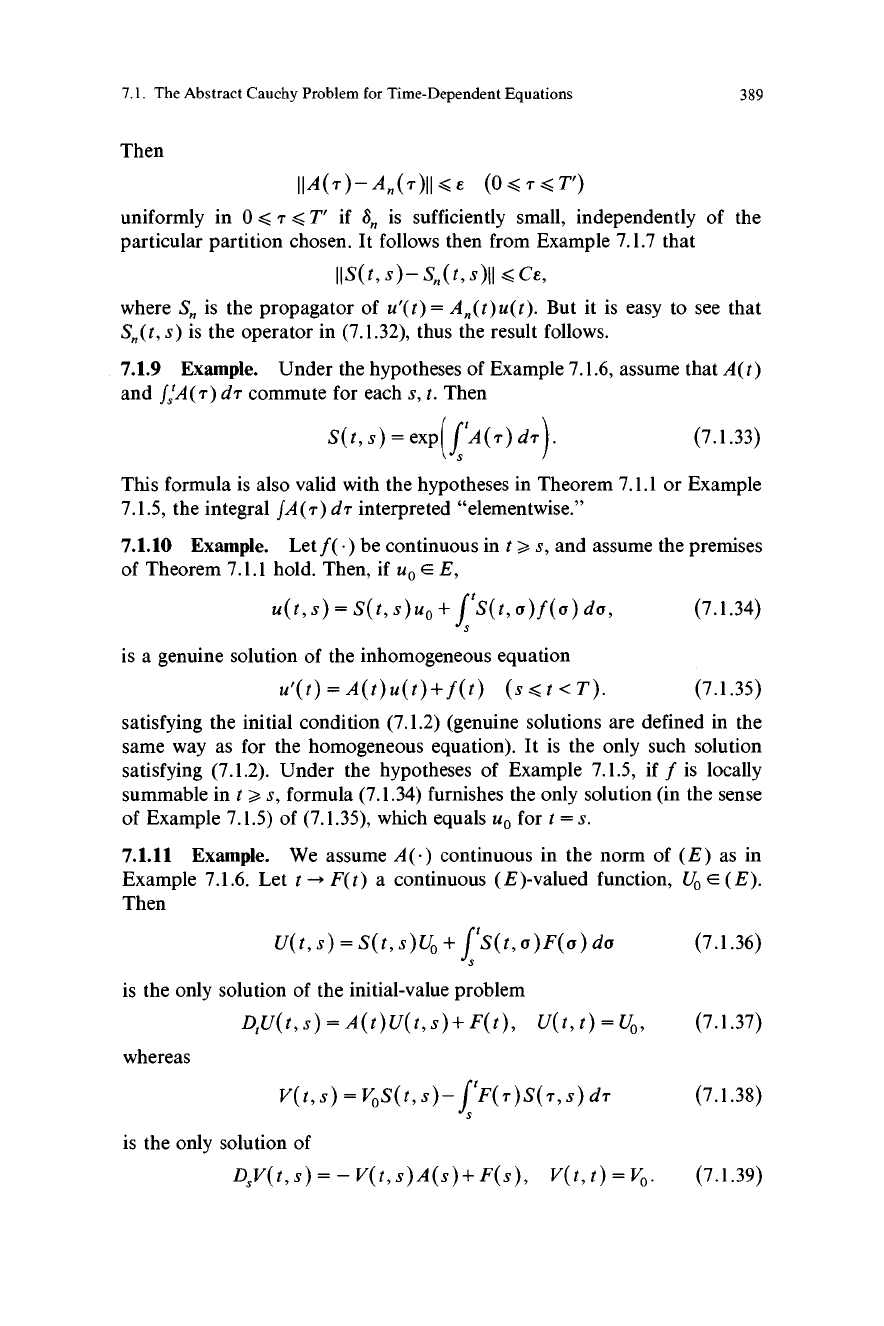
7. 1. The Abstract Cauchy Problem for Time-Dependent Equations
389
Then
IIA(T)-An(T)II <E (O<T<T')
uniformly in 0 < T < T' if S is sufficiently small, independently of the
particular partition chosen. It follows then from Example 7.1.7 that
IIS(t, s)-SIP, s)II <Ce,
where S is the propagator of u'(t) = A,, (t) u(t ). But it is easy to see that
s) is the operator in (7.1.32), thus the result follows.
7.1.9 Example. Under the hypotheses of Example 7.1.6, assume that A(t )
and JstA(T) dT commute for each s, t. Then
S(t, s) = exp(f tA(T) dT). (7.1.33)
S
This formula is also valid with the hypotheses in Theorem 7.1.1 or Example
7.1.5, the integral JA(T) dT interpreted "elementwise."
7.1.10
Example. Let ft-) be continuous in t >_ s, and assume the premises
of Theorem 7.1.1 hold. Then, if uo E E,
u(t,s)=S(t,s)uo+ ftS(t,a)f(a)da,
(7.1.34)
S
is a genuine solution of the inhomogeneous equation
u'(t)=A(t)u(t)+f(t) (s<t<T).
(7.1.35)
satisfying the initial condition (7.1.2) (genuine solutions are defined in the
same way as for the homogeneous equation). It is the only such solution
satisfying (7.1.2). Under the hypotheses of Example 7.1.5, if f is locally
summable in t >, s, formula (7.1.34) furnishes the only solution (in the sense
of Example 7.1.5) of (7.1.35), which equals uo for t = s.
7.1.11
Example. We assume A(.) continuous in the norm of (E) as in
Example 7.1.6. Let t -* F(t) a continuous (E)-valued function, Uo E (E).
Then
U(t,s)=S(t,s)U0+ ftS(t,a)F(a)da
(7.1.36)
S
is the only solution of the initial-value problem
DtU(t,s)=A(t)U(t,s)+F(t), U(t,t)=Uo,
(7.1.37)
whereas
V(t,s)=VOS(t,s)- ftF(T)S(T,s)dT
(7.1.38)
S
is the only solution of
DSV(t, s) = - V(t, s)A(s)+ F(s),
V(t, t) = Vo. (7.1.39)
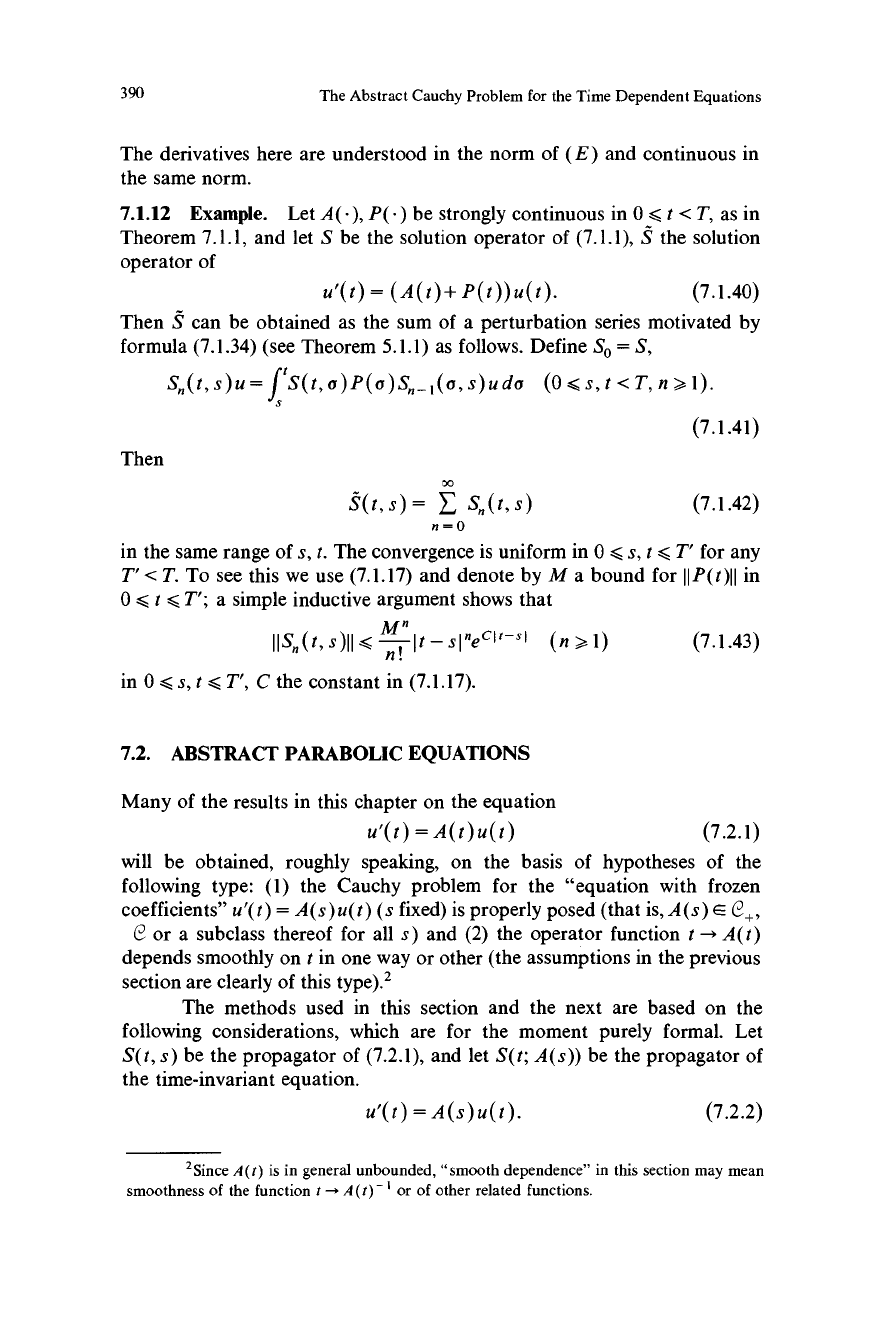
390
The Abstract Cauchy Problem for the Time Dependent Equations
The derivatives here are understood in the norm of (E) and continuous in
the same norm.
7.1.12 Example.
Let A(-),
be strongly continuous in 0 < t < T, as in
Theorem 7.1.1, and let S be the solution operator of (7.1.1), S the solution
operator of
u'(t) _ (A(t)+P(t))u(t). (7.1.40)
Then S can be obtained as the sum of a perturbation series motivated by
formula (7.1.34) (see Theorem 5.1.1) as follows. Define So = S,
S,,(t,s)u= ftS(t,(Y)P((Y)Sn_1(a,s)udo
(0<s,t<T,n>,1).
(7.1.41)
Then
00
S(t,s)= E Sn(t,s)
(7.1.42)
n=0
in the same range of s, t. The convergence is uniform in 0 S s, t s T' for any
T'< T. To see this we use (7.1.17) and denote by M a bound for I I P(t )I I in
0 S t S T'; a simple inductive argument shows that
nt
It-sln
aCat-l
(n a1)
(7.1.43)
IISn(t,s)II<
n
in 0 < s, t 5 T', C the constant in (7.1.17).
7.2. ABSTRACT PARABOLIC EQUATIONS
Many of the results in this chapter on the equation
u'(t) = A(t)u(t)
(7.2.1)
will be obtained, roughly speaking, on the basis of hypotheses of the
following type: (1) the Cauchy problem for the "equation with frozen
coefficients" u'(t) = A(s)u(t) (s fixed) is properly posed (that is, A(s) E (2+,
or a subclass thereof for all s) and (2) the operator function t - A(t)
depends smoothly on t in one way or other (the assumptions in the previous
section are clearly of this
type).2
The methods used in this section and the next are based on the
following considerations, which are for the moment purely formal. Let
S(t, s) be the propagator of (7.2.1), and let S(t; A(s)) be the propagator of
the time-invariant equation.
u'(t) = A(s)u(t). (7.2.2)
2Since A(t) is in general unbounded, "smooth dependence" in this section may mean
smoothness of the function t - A(t)- 1 or of other related functions.
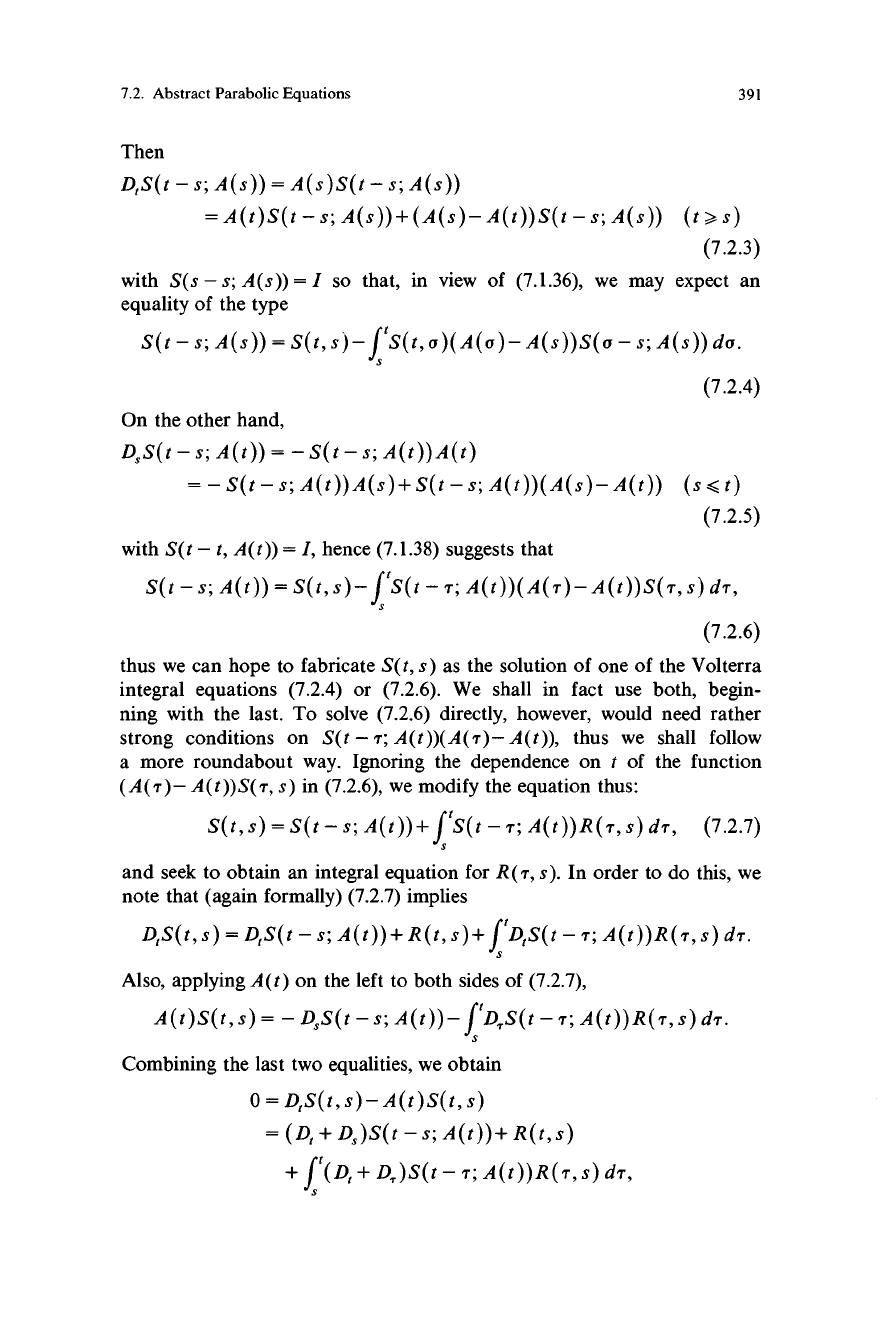
7.2. Abstract Parabolic Equations
391
Then
D,S(t - s; A(s)) = A(s)S(t - s; A(s))
= A(t)S(t - s; A(s))+(A(s)-A(t))S(t - s; A(s)) (t >-s)
(7.2.3)
with S(s - s; A(s)) = I so that, in view of (7.1.36), we may expect an
equality of the type
S(t - s; A(s)) = S(t, s) - f tS(t, a)(A(a)-A(s))S(a - s; A(s)) do.
S
(7.2.4)
On the other hand,
DDS(t - s; A(t)) = - S(t - s; A(t))A(t)
_ - S(t - s; A(t))A(s)+S(t - s; A(t))(A(s)- A(t))
(s < t)
(7.2.5)
with S(t - t, A(t)) = I, hence (7.1.38) suggests that
S(t - s; A(t)) = S(t, s) - f tS(t - T; A(t))(A(T)- A(t))S(T, s) dT,
s
(7.2.6)
thus we can hope to fabricate S(t, s) as the solution of one of the Volterra
integral equations (7.2.4) or (7.2.6). We shall in fact use both, begin-
ning with the last. To solve (7.2.6) directly, however, would need rather
strong conditions on S(t - T; A(t))(A(T)- A(t)), thus we shall follow
a more roundabout way. Ignoring the dependence on t of the function
(A(T)- A(t))S(T, s) in (7.2.6), we modify the equation thus:
S(t,s)=S(t-s;A(t))+ ftS(t-T;A(t))R(T,s)dT,
(7.2.7)
and seek to obtain an integral equation for R(T, S). In order to do this, we
note that (again formally) (7.2.7) implies
D,S(t, s) = D1S(t - s; A(t))+R(t, s) + f tDS(t - T; A(t))R(T, s) dT.
Also, applying A(t) on the left to both sides of (7.2.7),
A(t)S(t, s) DS(t - s; A(t))- f tDTS(t - T; A(t))R(T, s) dT.
S
Combining the last two equalities, we obtain
0 = D,S(t, s)- A(t)S(t, s)
= (D, + DD)S(t - s; A(t))+R(t, s)
+ f t(D1 + D,T)S(t - T; A(t))R(T, s) dT,
s
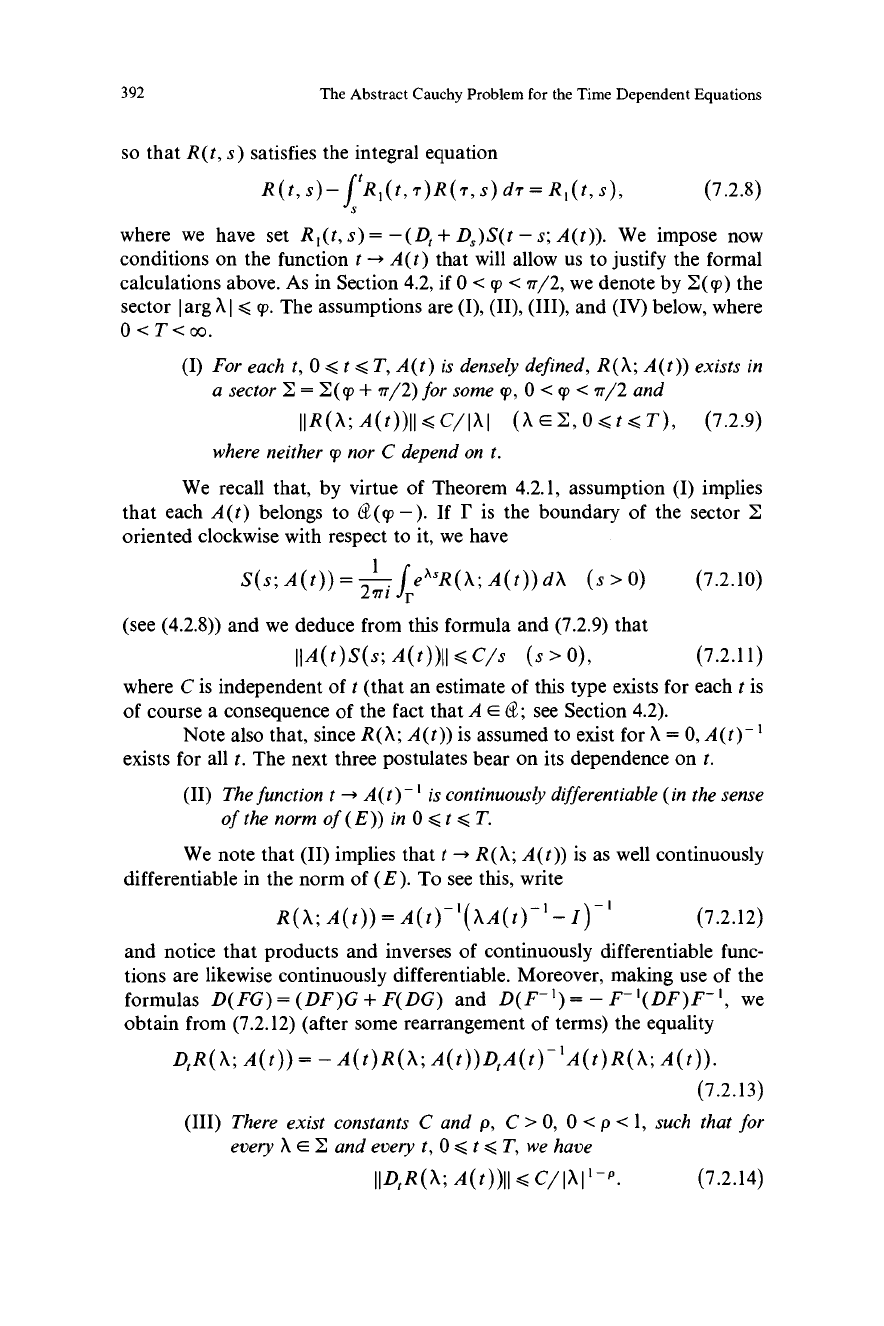
392
The Abstract Cauchy Problem for the Time Dependent Equations
so that R(t, s) satisfies the integral equation
R(t,s)- f`R,(t,T)R(T,s)dT=R,(t,s), (7.2.8)
S
where we have set RI(t, s) = -(D1 + Ds) S(t - s; A(t)). We impose now
conditions on the function t --> A(t) that will allow us to justify the formal
calculations above. As in Section 4.2, if 0 < q) < it/2, we denote by 2(q)) the
sector I arg X I < T. The assumptions are (I), (II), (III), and (IV) below, where
0<T<oo.
(I) For each t, 0 < t <T, A(t) is densely defined, R(X; A(t)) exists in
a sector I = I (T + Ir/2) for some (p, 0 < q) < ?T12 and
IIR(X;A(t))II<C/IXI
(X(=-2,O<t<T),
(7.2.9)
where neither rp nor C depend on t.
We recall that, by virtue of Theorem 4.2.1, assumption (I) implies
that each A(t) belongs to @ (qq -). If I' is the boundary of the sector 2
oriented clockwise with respect to it, we have
S(s; A(t))
2 --
fee?sR(X; A(t)) dX (s > 0) (7.2.10)
,r i
(see (4.2.8)) and we deduce from this formula and (7.2.9) that
IIA(t)S(s;A(t))II <C/s (s>0),
(7.2.11)
where C is independent of t (that an estimate of this type exists for each t is
of course a consequence of the fact that A (=- d; see Section 4.2).
Note also that, since R(X; A(t)) is assumed to exist for A = 0, A(t)
'
exists for all t. The next three postulates bear on its dependence on t.
(II) The function t - A(t)-' is continuously differentiable (in the sense
of the norm of (E)) in 0 < t < T.
We note that (II) implies that t -* R(X; A(t)) is as well continuously
differentiable in the norm of (E). To see this, write
R(A;A(t))=A(t)-'(AA(t)-'-I)-'
(7.2.12)
and notice that products and inverses of continuously differentiable func-
tions are likewise continuously differentiable. Moreover, making use of the
formulas D(FG) = (DF)G + F(DG) and D(F-') = - F-'(DF)F-', we
obtain from (7.2.12) (after some rearrangement of terms) the equality
D,R(A; A(t))
A(t)R(A; A(t))DA(t)-'A(t)R(A; A(t)).
(7.2.13)
(III) There exist constants C and p, C > 0, 0 < p < 1, such that for
every A E 2 and every t, 0 < t < T, we have
IID,R(A;A(t))II
<C/IAI'-P.
(7.2.14)
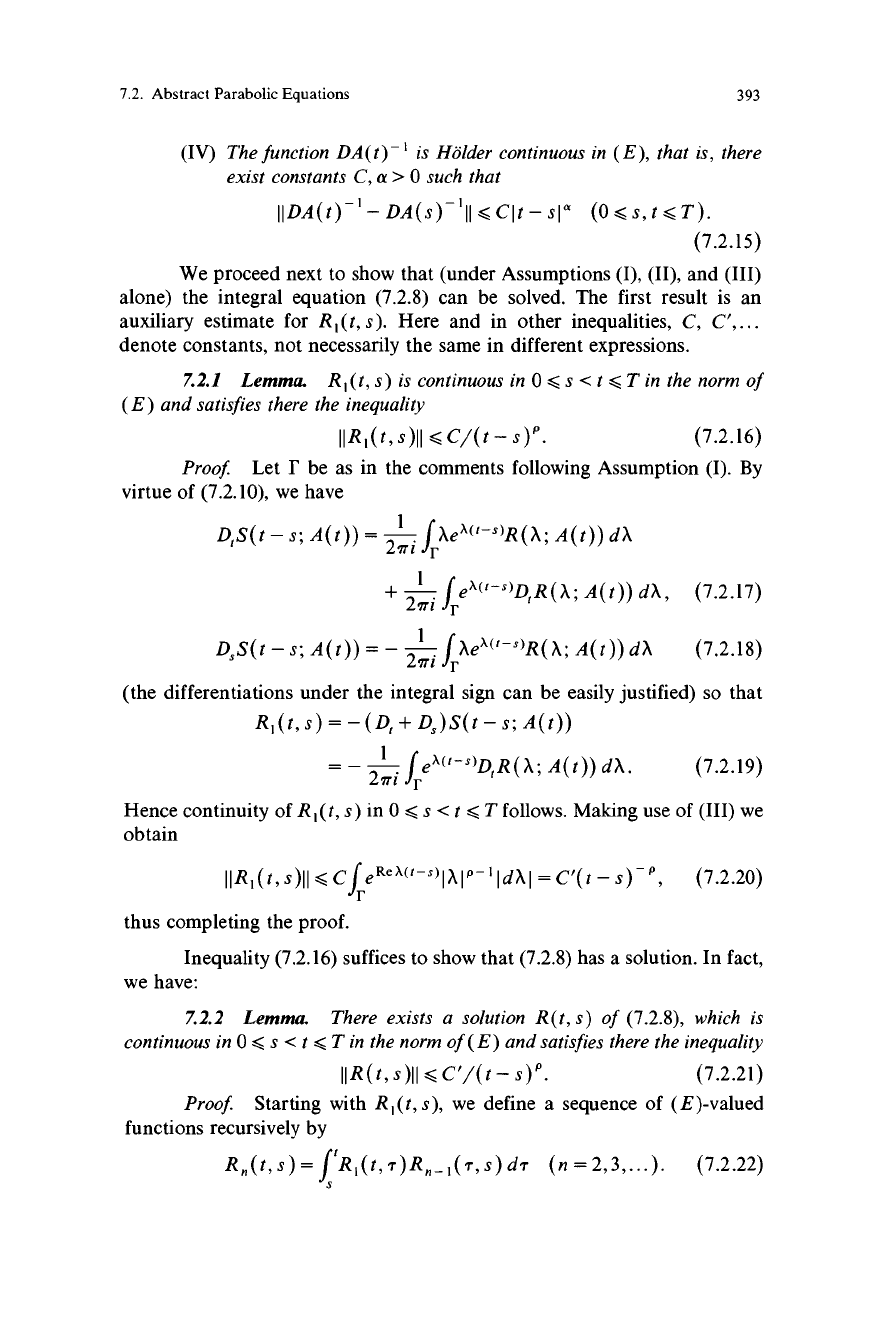
7.2. Abstract Parabolic Equations
393
(IV) The function DA(t)-1 is Holder continuous in (E), that is, there
exist constants C, a > 0 such that
IIDA(t)-'-DA(s)-'II
<CIt-sI" (0<s,t<T).
(7.2.15)
We proceed next to show that (under Assumptions (I), (II), and (III)
alone) the integral equation (7.2.8) can be solved. The first result is an
auxiliary estimate for R I (t, s). Here and in other inequalities, C, C',...
denote constants, not necessarily the same in different expressions.
7.2.1 Lemma. R , (t, s) is continuous in 0 < s <t < T in the norm of
(E) and satisfies there the inequality
IIRI(t,s)II<C/(t-s)P
(7.2.16)
Proof. Let F be as in the comments following Assumption (I). By
virtue of (7.2.10), we have
D,S(t-s;A(t))=
2Iri
f Xe"(`s)R(X;A(t))dX
+
1 f
A(t)) dX,
(7.2.17)
2Iri F
f Xe"(`-s)R(X; A(t)) dX
(7.2.18)
DSS(t - s; A(t)) = -
-
217i F
(the differentiations under the integral sign can be easily justified) so that
R,(t, s) = -(D,+ Ds)S(t - s; A(t))
-
1 fe"('-s)DtR(X;
A(t)) A.
(7.2.19)
21ri r
Hence continuity of R I (t, s) in 0 < s < t < T follows. Making use of (III) we
obtain
IIRI(t,s)II<C
freReX(t-s)IXIP-'Id1vI=C'(t-s)-P
(7.2.20)
thus completing the proof.
Inequality (7.2.16) suffices to show that (7.2.8) has a solution. In fact,
we have:
7.2.2
Lemma. There exists a solution R(t, s) of (7.2.8), which is
continuous in 0 < s < t < Tin the norm of (E) and satisfies there the inequality
IIR(t, s)II <C'/(t - s)". (7.2.21)
Proof. Starting with R i (t, s), we define a sequence of (E)-valued
functions recursively by
Rn(t,s)= f tR1(t,T)Rn-1(T,s)dT
(n=2,3,...). (7.2.22)
S
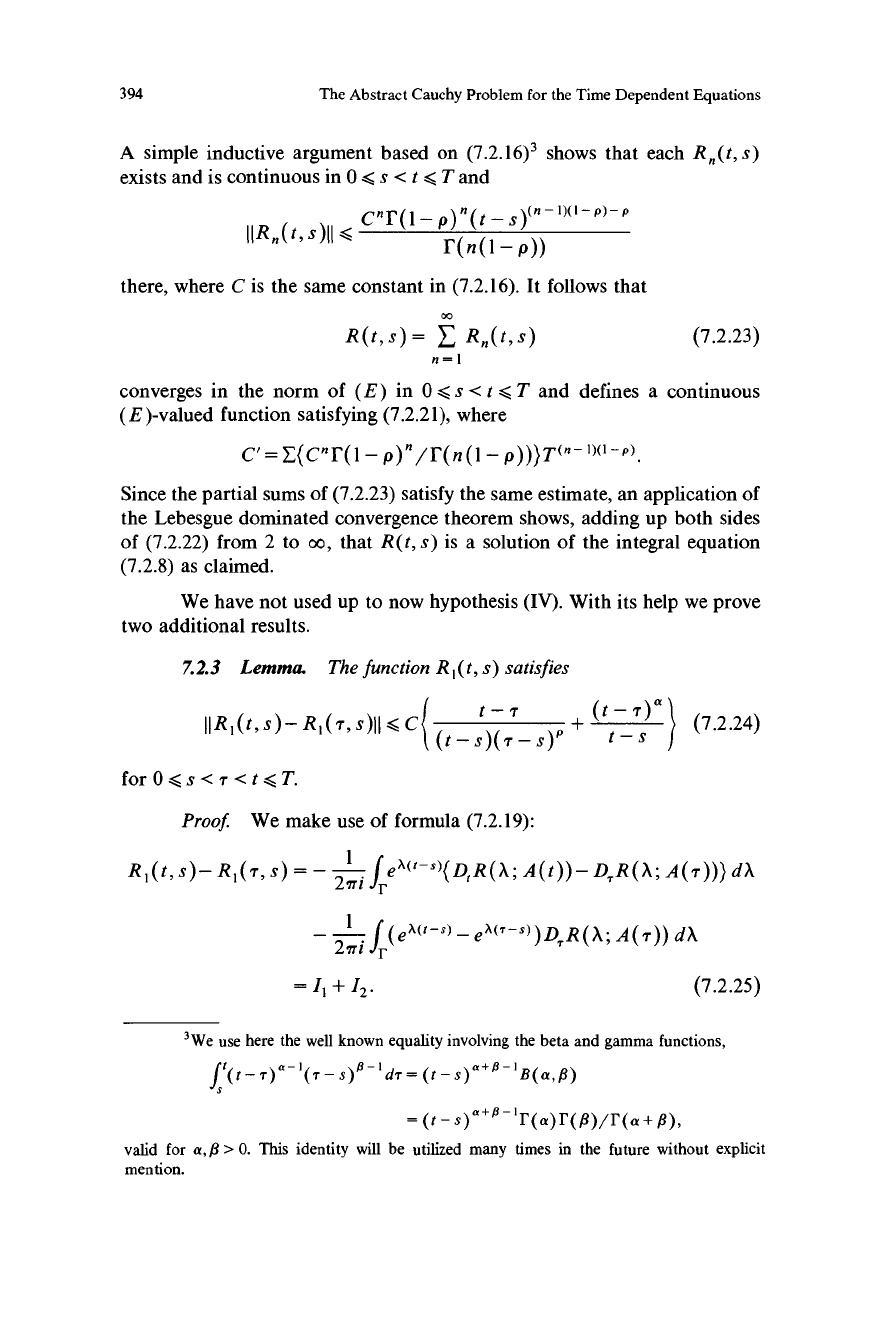
394
The Abstract Cauchy Problem for the Time Dependent Equations
A simple inductive argument based on (7.2.16)3 shows that each Rn(t, s)
exists and is continuous in 0 < s < t < T and
Cnr(I-p)n(t-s)(n-1)(I-P)-P
IIR.(t, S)II <
I'(n(I - p))
there, where C is the same constant in (7.2.16). It follows that
00
R(t, s) = E Rn(t, s) (7.2.23)
n=I
converges in the norm of (E) in 0 < s < t < T and defines a continuous
(E )-valued function satisfying (7.2.21), where
C'=E(CnI'(l-
p)n/I'(n(I-p)))T(n-1)(1-P),
Since the partial sums of (7.2.23) satisfy the same estimate, an application of
the Lebesgue dominated convergence theorem shows, adding up both sides
of (7.2.22) from 2 to oo, that R(t, s) is a solution of the integral equation
(7.2.8) as claimed.
We have not used up to now hypothesis (IV). With its help we prove
two additional results.
7.2.3 Lemma. The function R 1(t, s) satisfies
l
IIR1(t,s)-R1(T,s)II<C(
t-T
P+(t
t_ )a) (7.2.24)
l (t-S)(T-S) J
for 0,<S< T<t,<T.
Proof. We make use of formula (7.2.19):
R1(t,s)-R1(T,s)
2Iri
frea('-s)(DR(X;A(t))-DTR(X;A(T)))dX
1 f
2Tri
T
= I1 + I2. (7.2.25)
3We/use here the well known equality involving the beta and gamma functions,
J t(t - T).- I (T - S)S-1 dT = (t -
S)a+fl-I
B(a,p)
_ (t -
s)'+[3-'r(a)r($)/r(a+
fi)
valid for a, $ > 0. This identity will be utilized many times in the future without explicit
mention.
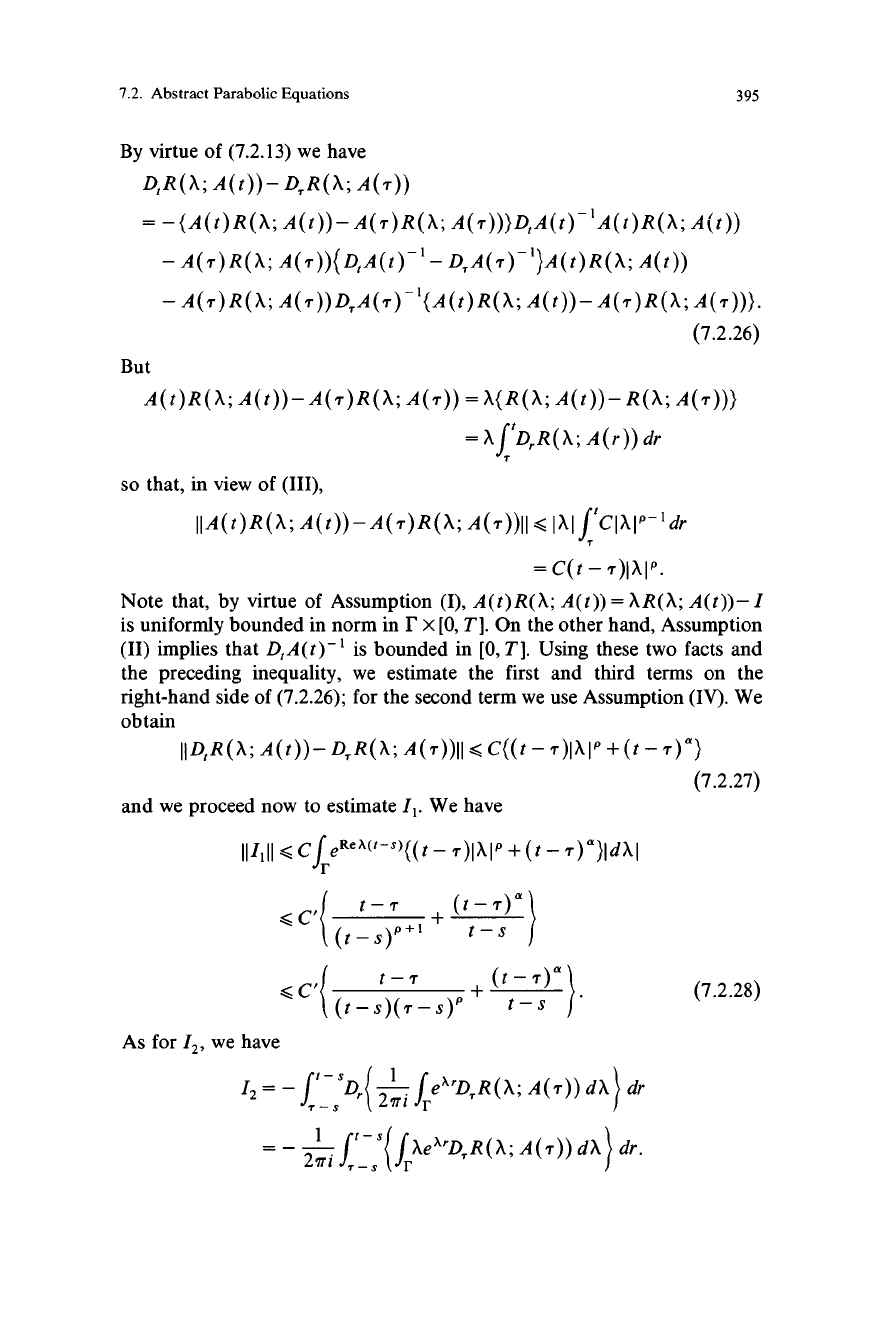
7.2. Abstract Parabolic Equations
395
By virtue of (7.2.13) we have
D,R(X; A(t))- DR (A; A (T))
_ -{A(t)R(X; A(t))-A(T)R(A; A(T)))D1A(t)-'A(t)R(X; A(t))
- A(T)R(X; A(T))(D,A(t)-'
-
DTA(T)-')A(t)R(X; A(t))
- A(T)R(X; A(T))DTA(T) '{A(t)R(X; A(t))-A(T)R(X; A(T))).
(7.2.26)
But
A(t)R(X; A(t))- A(T)R(X; A(T)) = X(R(X; A(t))- R(X; A(T)))
= X
f'D,.R(X; A(r)) dr
so that, in view of (III),
IIA(t)R(X; A(t))-A(T)R(X; A(T))II < IXI f
ICIXIP-'dr
T
=C(t-T)IXIP.
Note that, by virtue of Assumption (I), A(t)R(X; A(t)) = XR(X; A(t))- I
is uniformly bounded in norm in IF x [0, T]. On the other hand, Assumption
(II) implies that DDA(t)-' is bounded in [0, T]. Using these two facts and
the preceding inequality, we estimate the first and third terms on the
right-hand side of (7.2.26); for the second term we use Assumption (IV). We
obtain
IID:R(X;A(t))-DTR(X;A(T))II
SC((t-T)IXIP+(t-T)«)
(7.2.27)
and we proceed now to estimate I. We have
111111<1 C
freRea(t-s)((t-T)IXIP+(t-T)°`)IdXl
C {
t - T +
(t-S)P+1
t - S
C,{
S)(
T
T
- S)P
+ (tt-
)a
(7.2.28)
As for I2, we have
IZ
- f
t-sDr{2_1 fre"DTR(x;A(T))dX}dr
=_
I
ft-s{ fxexrDR(x;
A(T)) dX l dr.
2;i T - S
r
11
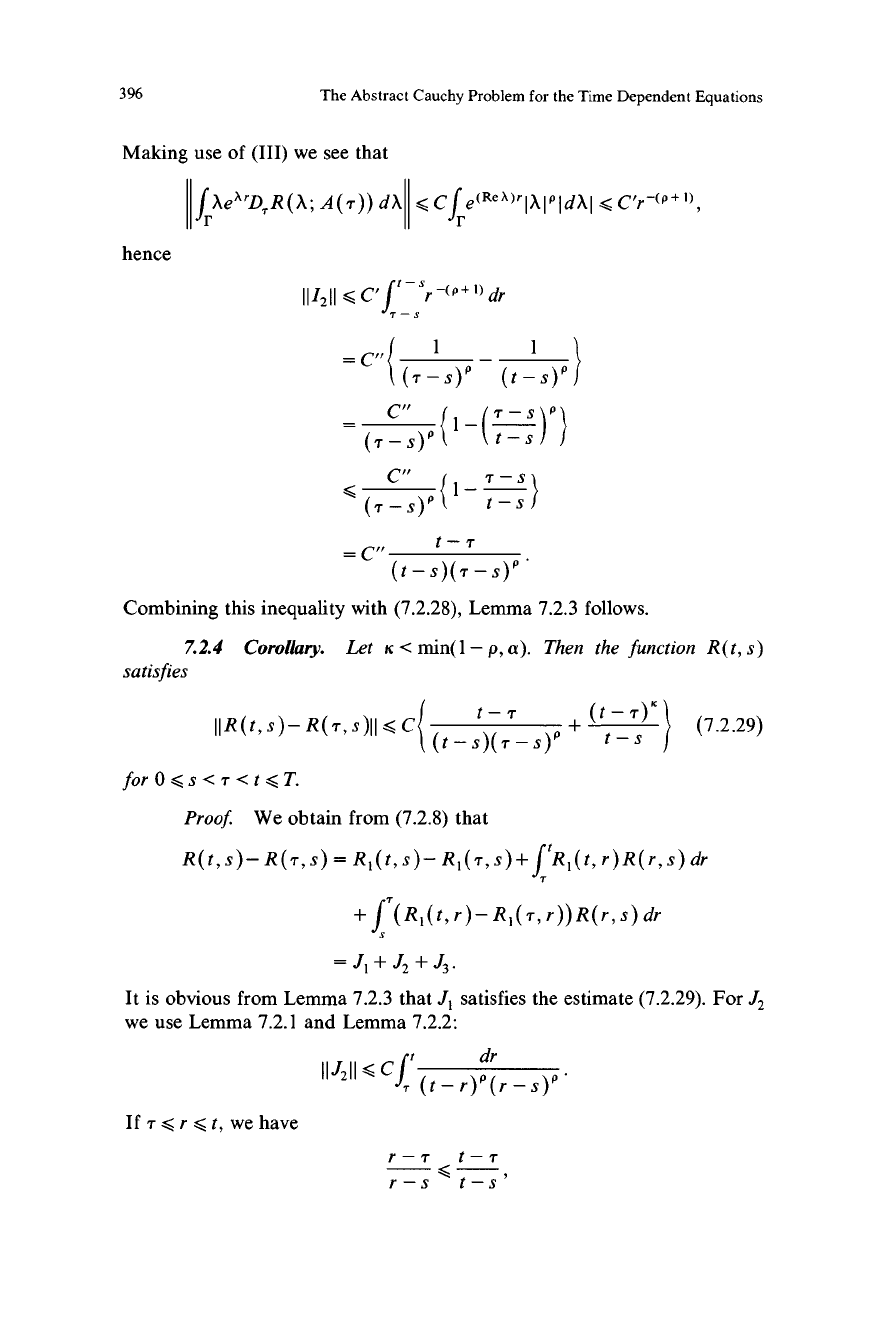
396
The Abstract Cauchy Problem for the Time Dependent Equations
Making use of (III) we see that
fr
XexDTR(X; A(T)) dX
hence
= C,,
(t-S)(T-S)P
Combining this inequality with (7.2.28), Lemma 7.2.3 follows.
7.2.4
Corollary.
Let K < min(1- p, a). Then the function R(t, s)
satisfies
IIR(t,s)-R(T,s)II
<C
(t -
St
)( T
P
+ (t-T)K
(7.2.29)
111
T - S)
t - S
for 0 < s < T < t < T.
Proof. We obtain from (7.2.8) that
R(t, s)- R(T, s) = R1(t, s)- R1(T, s)+ f tR,(t, r)R(r, s) dr
+ fT(R1(t, r)-RI(T, r))R(r, s) dr
=J1+J2+J3.
It is obvious from Lemma 7.2.3 that J, satisfies the estimate (7.2.29). For J2
we use Lemma 7.2.1 and Lemma 7.2.2:
IIJ2II <C
f`(t-r)d(r-s)P
If T < r < t, we have
<C f e(ReX)rlXIPI dAI <C'Y-(P+
r
t - S
111211<C"I
Jr T
r
S
-(P+ 1) dr
1
_ 1
wr
(TS)'
(tS)'
Crr
P { 1 -
(
t -
s y'I
(T - S)
C,, T - S
(T-S)"
t - S
t- T
r- T t- T
r -s t - s
